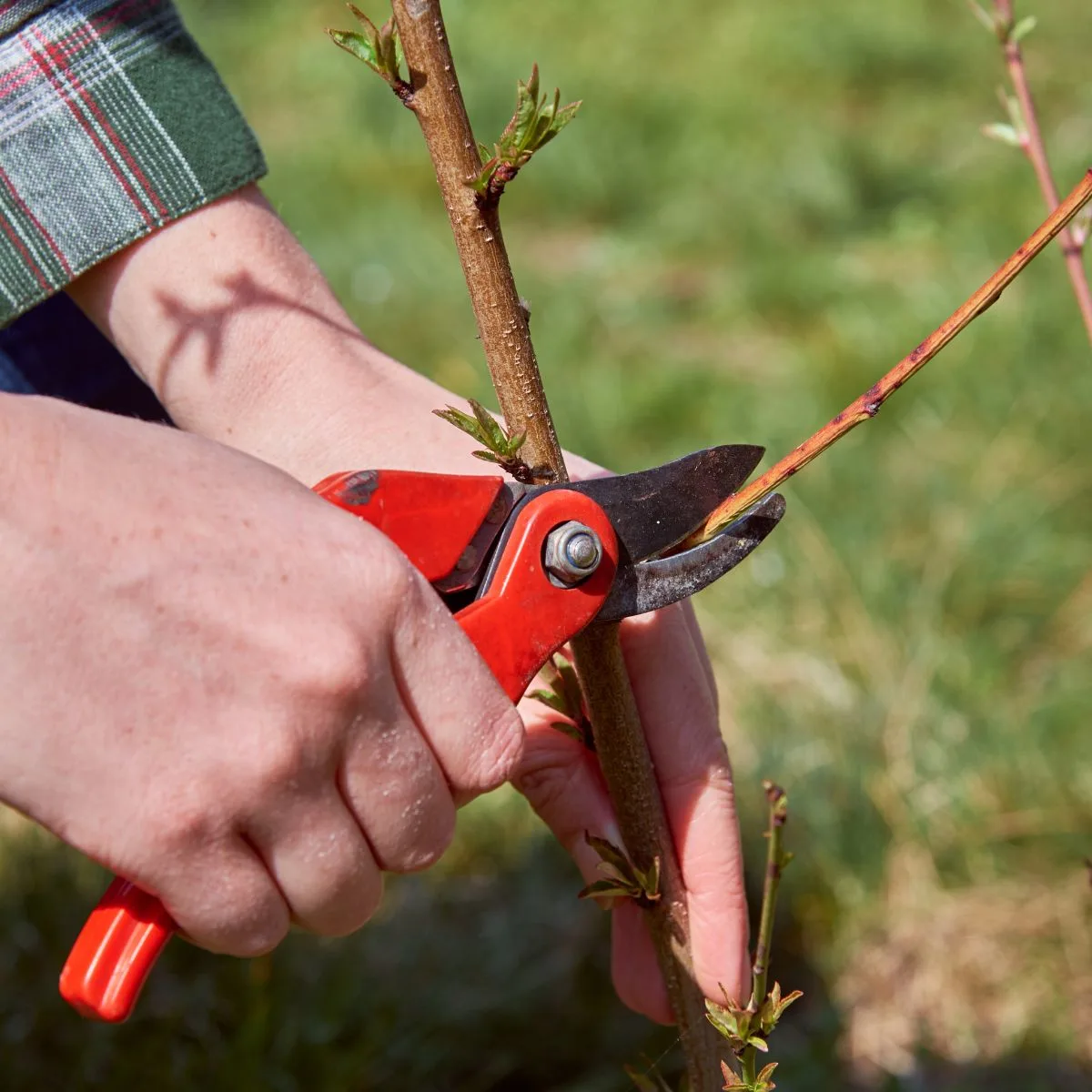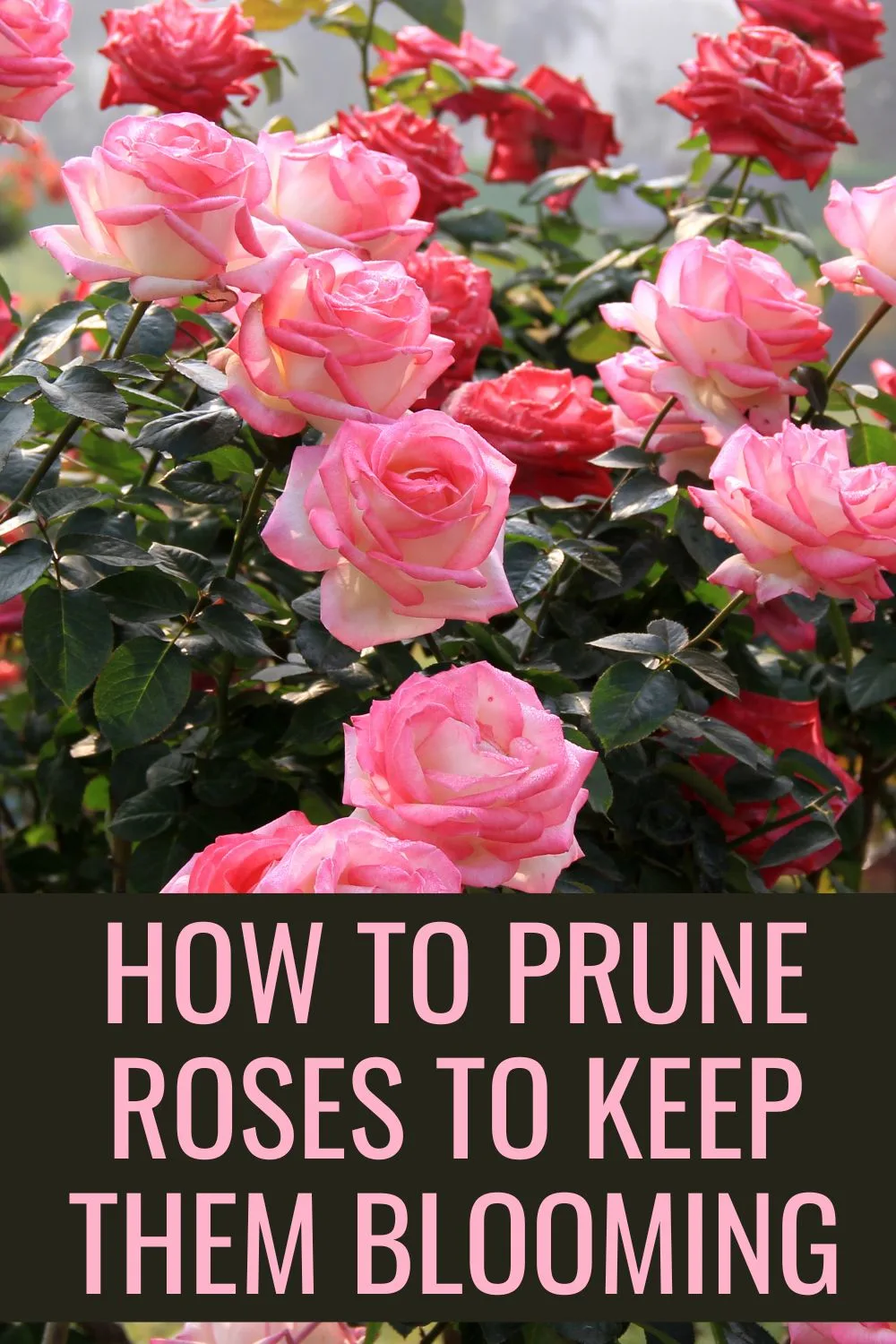If you want beautiful, healthy rose bushes, you need to learn how to prune roses. Roses are well known for being challenging to prune, but it’s also an important part of the process of tending to them. You shouldn’t let their thorns and sometimes uncontrolled growth intimidate you into believing they may be next to impossible to prune! Once you have the correct steps for shaping your beautiful roses, you’ll find yourself to be excited about the process! How do you prune roses?
Pruning roses is not difficult if you have the necessary gear and do it correctly. Make sure you have garden gloves, pruning shears, and safety goggles for the job. Remove dead leaves and weak growth, sealing all fresh cuts after cutting them at a 45-degree angle. Always fertilize after pruning.

Knowing how to prune your roses correctly will benefit them and make for a more aesthetically pleasing rose bed or garden. Keep reading to know all the necessary tools and step you need for trimming roses. First, let’s look at why it’s so important.
Related: How to prune drift roses.
The Importance Of Pruning Your Roses
Roses are a beautiful addition to any garden, but they require a bit of care to stay healthy and bloom. One important task is pruning, which helps to encourage new growth and remove dead wood or damaged branches. While it may seem counterintuitive to cut back roses, pruning helps them produce more flowers. It also keeps the roses looking tidy and shapely.

Getting the timing right on when to prune your roses is generally determined by the class of your rose plant and the hardiness zone it grows in. However, most rose pruning is done during the spring before the blooms start to show.
You must watch your rose plant carefully during this time, as the lead buds should start swelling and taking on a reddish color. This is when you can be sure it’s the best time for some pruning! However, it might be good to remember that some types of roses would be better to prune just before breaking dormancy.
It’s essential to prune your roses, for the following reasons:
- to remove any diseased or dead branches
- rejuvenate the plant
- encourage blooming
- control its shape and size
- to encourage more airflow through the shrub, making for a more successful plant
For best results, roses should be pruned in early spring, just before new growth begins. With a sharp pair of shears, cut back each branch by about one-third. This may seem like a lot, but don’t be afraid to prune roses aggressively. They will quickly rebound with beautiful new growth.
More Help For Growing Beautiful Roses
If you love roses in your garden, you might also be interested in these other ideas and tips:
- Types of roses
- The most fragrant roses
- Landscaping with knockout roses
- Tips for growing pretty roses
- Best companion plants for roses
- Landscaping with roses
Rose Types

For the most part, the rules for pruning roses are based on the rose type. Roses are one of the most popular flowers in the world. They come in a wide variety of colors, sizes, and shapes. roses can be classified according to their use, growth habit, and structure. The most common classifications are:
- bush roses
- climbing rose
- groundcover roses
- miniature roses
- polyanthas roses
- gallicas
- damask roses
- moss roses
- China roses
- English roses
- hybrid tea roses
- grandiflora roses
- Rambler roses
- wild roses
- old garden roses
- landscape roses
Each type of rose has its own unique characteristics. Bush roses, for example, are typically large and upright in shape. They produce a large number of flowers and have a long blooming season. Climber roses are similar to bush roses, but they have longer stems that can be trained to climb walls or other structures.
Groundcover roses are low-growing plants that spread quickly and are often used to cover bare patches of ground. Miniatures roses are small plants that produce miniature flowers. Polyanthas roses are hybrid plants that have been bred to produce multiple colors on a single plant. Ramblers roses are vigorous climbing plants that produce a large number of small flowers.
Let’s look at what you need to prune your beloved roses and how to do it in a few simple steps!
What Do You Need To Prune Your Roses?
When it comes to pruning your roses, it’s all about safety first! Make sure you have these tools before you start the pruning process, as it would make the whole process a lot easier. Roses are beautiful, delicate flowers that require special care when pruning.
The first step is to choose the right tools for the job. For example, a small pair of pruning shears is ideal for trimming dead leaves and stems, while a larger pair of loppers is better suited for cutting thicker branches. Roses also have sharp thorns, so it’s important to wear gloves to protect your hands.
Here are some things you may need:
1. Thick garden gloves and long sleeve shirts
Make sure you have suitable gloves that are a tight fit. They should be thick enough to withstand the thorny nature of these plants.
Also, it would help to have a layer or two of thick and long-sleeved shirts in case your arms come into contact with the rose’s thorns.
2. Safety goggles
As the branches have a tendency to whip back unexpectedly, it would help if you wore a pair of safety goggles. If you do not have safety goggles yet, you could also use a pair of sunglasses to protect your eyes.
3. Hand pruners or hand saw
If your rose plant is relatively small, hand pruners will be perfect for the job. However, you may need loppers, or a small hand saw for a bigger rose bush with larger canes.
4. Rubbing alcohol or disinfectant
When it comes to pruning any plant, you need to make sure your pruning tools are sharp and clean.
If you have used them before to prune a diseased plant, it will be best to wipe your tools down with disinfectant or rubbing alcohol to sterilize them.
Additionally, it would be best to sterilize your pruning tool again after cutting a diseased or dead part of your rose bush, as some diseased may be transferrable to other healthy or weaker parts.
5. Know how and where to make your cuts
Always clean-cut all stems at a 45-degree angle at least a quarter inch above an outward-facing bud. This will allow the plant to grow outward and upwards rather than on itself.
3 Ways To Trim Roses

Once you have the proper tools, you can begin pruning your roses. Start by removing any dead or diseased leaves and stems, then trim back any long or overgrown branches. Be sure to make a clean cut at an angle, and don’t forget to fertilize your roses afterward to help them recover from the pruning process. With a little time and care, you can keep your roses looking their best all season long.
There are three basic classifications of types of pruning:
- Hard pruning – This is a more severe form of pruning where you take back 3-5 buds per stem from the base of the plant.
- Thinning out – Cutting back just some canes from the base of the plant. Often used diseased canes (or for dead canes). Leave healthy canes to continue growing.
- Heading back – This refers to moderate pruning where they are cut back but about 1/3.
If you’ve been talking to other rose keepers or reading up on the subject, you’ve probably heard these terms already. Now that you know what they mean, let’s look at a step-by-step walkthrough of how to do it.
How To Prune Your Roses Step By Step
You may be pleasantly surprised to know that modern roses don’t need to be pruned as much as you would think. For thriving and beautiful-looking roses, follow these helpful steps as closely as you can:
1. Remove any diseased leaves
Removing the damaged and diseased leaves on your rose plant will give you a clear image of the structure of the bush and the stems. This step will also help to remove any pests that may hide in the foliage.
2. Remove weak or dead stems
Cut into the stems; if the stems are brown, you can be sure they’re close to death or already dead. If the stem is still green, you can choose to leave it, even if it seems to be weak. Be sure to cut any dead stems back to the base.
3. Open any crossing branches to get to the center of the shrub
Taking out the crossing branches is crucial, as they could rub and cause damage to your rose plant. They could also encourage diseases. The goal is to have branches facing in an upward direction, creating an open structure similar to a vase.
4. Remove all thin or weak growth
If you’re unsure about what growth to remove, a good rule to follow is to remove any growth that is thinner than a pencil. This will allow your plant to focus more on its existing healthy growth.
5: Prune remaining canes
Prune by cutting about a quarter to half an inch above an outward-facing bud, known as the small bump that can be seen where a leaf meets the stem. New stems will always grow in the direction of the bud. Your goal here is to encourage them to grow outwards instead of inwards.
Remember to make your cuts at a 45-degree angle sloping directly away from the bud, which will allow water to run off.
6. Seal all fresh cuts
It would be best if you protected freshly cut stems from rose borers and rot by sealing your plant’s “wounds” with a pruning compound. If you’re unsure, you can ask your local garden center for this medium.
7. Clean the surrounding area to avoid pests and diseases
After completing the pruning process, you need to ensure the surrounding area underneath your rose plant or bush is clean. All cut branches and leaves should be removed, as pests and diseases will be attracted to them.
8. Fertilize roses
Roses are well-known to be “big eaters” and need constant nutrition, so be sure to feed them with a high-quality and long-lasting fertilizer.
Rose Pruning Tips and Tricks
In time, the more you do it, the better you’ll get at pruning your roses. Here are some tips and tricks to help you get started on the right foot.
- Always make sure your pruning tools are sharp and clean. This will help you make clean cuts that won’t damage the plant.
- Prune early in the season while the plant is still dormant. This will encourage new growth and help the plant recover more quickly.
- Remove all dead, damaged, and diseased wood. This will help improve air circulation and prevent the spread of disease.
- When deadheading or cutting for floral arrangements, cut back to a strong part of the stem where there is a leaf with five leaflets versus just three. Cut above an outward-facing bud when possible and new shoots will grow in the same direction as the cut.
- Don’t be afraid to prune back significantly – roses are tough plants that can handle a lot of pruning.
More Pruning Guides
How To Prune Roses – Final Thoughts
Knowing what you need to prune your roses and how to go about it will make your efforts worth the while, and you may even come to enjoy it. While pruning your roses may seem like a daunting task, it’s actually quite simple once you know what you’re doing. And the benefits of pruning are well worth the effort.
By pruning your roses, you are encouraging new growth, removing damaged or diseased parts of the plant, and promoting air circulation. This results in healthier, more vibrant roses that are better able to withstand disease and pests. Pruning also encourages the plant to produce more flowers. So, if you’re looking for bigger and better blooms, prune your roses regularly!
From light pruning to heavy pruning to the base of the stem, it’s always a good idea to learn how to do it correctly. If you follow these tips, you’ll be well on your way to having healthy, beautiful roses.
Always practice patience, safety, and diligence when pruning your roses to ensure your rose garden looks as good as ever! Do you have any tips you would add to the list?

Adriana Copaceanu is a passionate nature lover living in the country on her dream property where she grows vegetables, lavender, and wildflowers that she shares with the wildlife they attract. When she's not in the garden, she loves spending time with her chickens and planning her next nature project. Check out her books below:
How to Grow Lavender for Fun and Profit: Lessons Learned from Planting Three Hundred Lavender Plants







The Most Fragrant Roses To Plant In Your Garden
Monday 15th of May 2023
[…] how to prune roses […]
Beautiful Red Flowering Shrubs That Make Your Landscape Pop
Tuesday 28th of February 2023
[…] how to prune roses […]
How To Prune Mums For Awesome Autumn Blooms
Thursday 10th of November 2022
[…] How to prune roses […]
How To Prune Tomato Plants - A Simple, Straightforward Guide
Thursday 10th of November 2022
[…] How to prune roses […]
How To Prune A Hibiscus - 5 Ways To Trim It For Gorgeous Flowers
Thursday 10th of November 2022
[…] How to prune roses […]